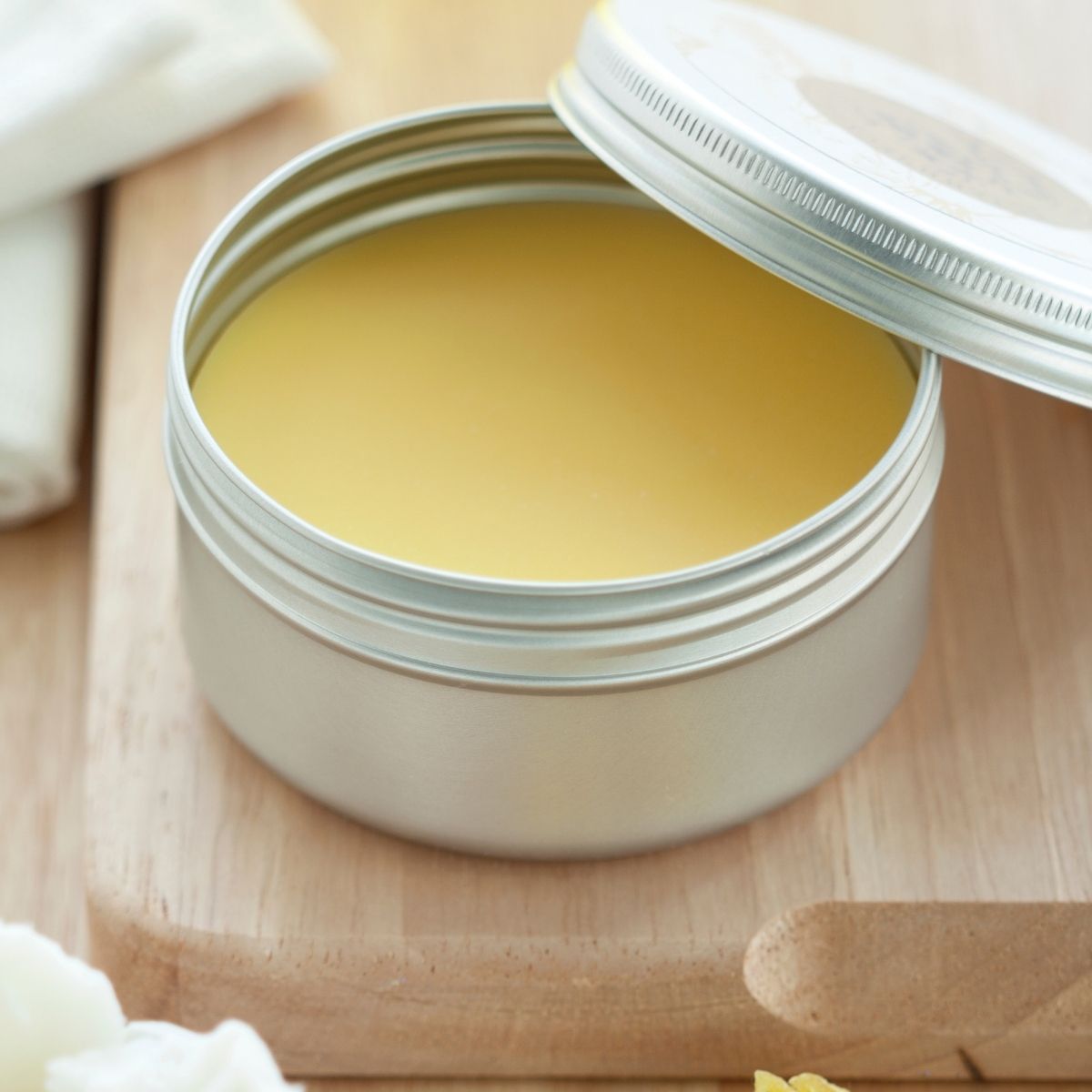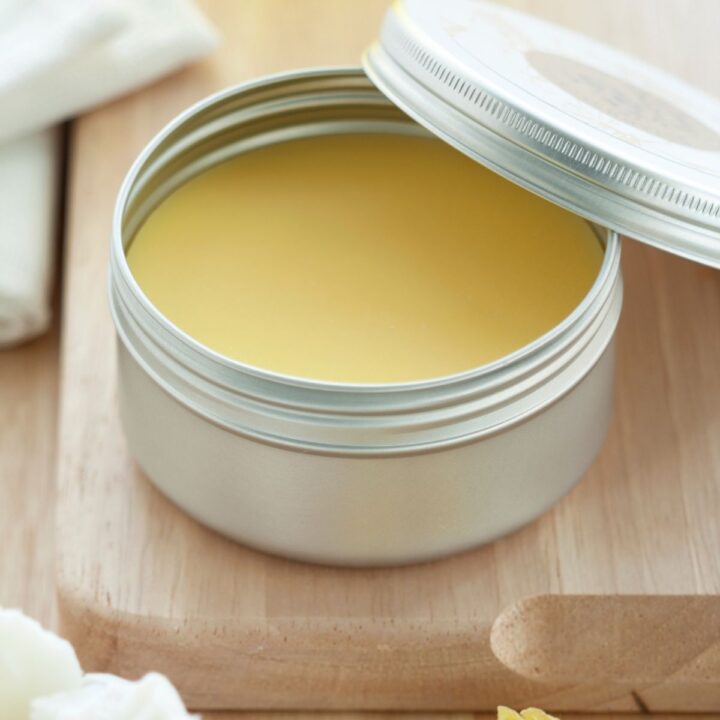Best Homemade Cast Iron Seasoning Paste
The best homemade cast iron seasoning paste for all your cast iron cookware. It’s simple to make and will last for months with regular use. Stop buying store-bought seasoning paste when it’s so simple to make your own!
Cast iron doesn’t have to be intimidating or complicated. It’s really neither of those things. Seasoning cast iron doesn’t need to be either.
This simple cast iron seasoning paste works well for a first time seasoning of a new pan as well as seasoning a frequently used one.

Some of these links are affiliate links. You can read my full disclosure HERE.
Purpose of seasoning cast iron
The purpose of seasoning cast iron is to create a beautiful non-stick surface. Cast iron with regular use and proper care will become non-stick. But it does require a bit of work to get it there.
How to clean your cast iron cookware
Like anything, you will get conflicting information when it comes to cast iron and how to properly care for it. Is there such a thing? My theory is this-if it works for you, that’s all that matters.
Some people will tell you to never get cast iron wet. “Never wash it with soap and water!”
Well folks, for me, when I buy a cast iron pan from a thrift store or a yard sale and its covered in debris and rust? You can certainly bet that I’ll be giving it a good scrubbing with a hot soapy water and a steel scrubber.
Washing it really well, at least the first time, will give you a nice clean base to start.
It’s true that you should never leave cast iron pans with water sitting in them. They will rust, they are made of iron. But if you are looking to just give them that initial cleaning. Use soap and water. Especially if there is rust already on the pan. You need to get that off BEFORE you season it.
- Wash pan with a hot soapy water and a steel scrubber.
- Allow pan to dry before using it or storing it. I prefer to place mine on my cooktop, turn the stove on and allow my pan to heat up to make sure its fully dry.
- Once your pan is clean and totally dry, you can start the seasoning application (see below for full instructions on this).
How to make the best cast iron seasoning paste
- Take a shallow pot or pan filled with 1 to 2 inches of water. Bring water to a boil then remove from heat.
- Fill seasoning paste jar with ingredients and place jar into the previously boiled pot of water.
- Allow mixture to melt, stir occasionally with a popsicle stick to incorporate. Place back on heat if needed. Be careful! Beeswax is flammable so do not leave this unattended while the stove is on.
- Once mixture has melted, remove from heat and allow to cool completely. Mixture will solidify.
- Use as needed to season cast iron cookware.
Don’t forget to print your recipe card (below) so you have it for later.
Tips for making the best cast iron seasoning paste
Making your own seasoning paste is super simple. Try out a couple different recipes and see which one you prefer and works best for you cooking needs.
After all, there are a ton of recipes out there and I’m not saying this one is the best. However, I have tried quite a few and this one has worked the best for me.
- Never leave your simmering ingredients unattended. Beeswax is highly flammable.
- Turn the heat off and allow your ingredients to fully cool before moving them around. This will prevent a potential mess and or serious burns from hot liquid.
- Use an old pan or thrift store pot to boil water in. IF the mixture happened to spill out, it can make a mess that will take some time to clean up.
- If using a microwave to melt ingredients, be sure and cover with a napkin or paper towel to prevent mixture from popping and making a mess.
Smoke point of cooking oils
The smoking point is when an oil begins to emit smoke. This indicates the release of fatty acids in the oil.
As the temperature of the oil rises, it turns into a fatty acid. The smoke point of each of the oils I’m about to discuss, is based on the duration as well as intensity of heat applied.
The best oil for seasoning cast iron
When it comes to oil and cast iron, really any oil will work.
Are there oils that will work better than others? Of course!
The most important consideration when it comes to choosing an oil is the smoke point.
Since seasoning cast iron requires high temperatures, consider using oils with higher smoke points.
After food-grade oils are applied to your pans, they are baked to or beyond their smoke points.
Let’s take a look at a few different oils. Hopefully this will help.
Animal fats for seasoning cast iron
- Lard (rendered pigs fat)
Lard has a smoke point of 375 degrees Fahrenheit. It is easy to find, inexpensive and easy to store. You can also use lard for frying.
- Beef Tallow (rendered beef fat)
Tallow has a smoke point of 420 degrees Fahrenheit. It is extremely shelf stable and can be really affordable and easy to source.
Tallow is also really easy to make yourself at home.
- Beeswax
Beeswax can be difficult to find and can be quite expensive (depending on the quality and source). It can be tricky to apply.
I prefer to melt it in a double broiler, melt the wax on a low heat so it becomes a liquid, then apply it to my cast iron with a rag.
I have have a bee hive here on our homestead so sourcing beeswax is easy for me.
Store bought oils
- Coconut oil
Coconut oil is also easy to find. It is easy to apply to cast iron. But is almost double the cost of shortening and the canola oils. Coconut oil has a smoke point of 350 degrees Fahrenheit.
- Shortening
Shortening is relatively inexpensive and easily found at most stores.
I have found, that shortening needs to be applied more frequently.
This of course will depend on how often you are using your cast iron pans. Frequent use, will require more frequent application.
- Vegetable and Canola Oils
Vegetable and canola oils are inexpensive, easy to find at every grocery store, and easy to apply. These oils have a smoke point of 400 degrees Fahrenheit.
- Olive Oil
The smoke point of olive oil is between 374-405 degrees. It can be expensive depending on the quality of oil you buy. Most grocery stores carry several brands ranging in price.
- Grapeseed Oil
Grapeseed oil has a smoke point of 420 degrees Fahrenheit.
Because of the high smoke point, low saturated fat content, and durability, it definitely tops the list of ones to use.
It has a neutral taste and order and creates a really nice durable coating on your cast iron cookware.
- Flaxseed Oil
Flaxseed oil can be very expensive.
It has a super low smoke point (225 degrees Fahrenheit) but bonds really well to cast iron. Flaxseed oil is still considered to be one of the best drying oils.
A drying oil simply means that it will dry out naturally and form a hard film on your pans surface.
If you really want a long lasting, durable coating on your cast iron pans, flax seed oil should be on the top of your list. it can help create that perfect non-stick coating we are all looking for.
If you decide to use flaxseed oil, be sure and use unfiltered, organic flax oil.

Can you use any oil to season cast iron?
You can of course use any oil or blend of oils to season cast iron with great success.
As I mentioned, some of the oils will require more frequent seasoning, while others will last significantly longer. It really comes down to personal preference and budget.
Making a blend of several oils can give you a simple cast iron seasoning paste that will work beautifully on all your cast iron cookware.
Can you season cast iron with olive oil?
Many people use olive oil to season cast iron because it is so readily available.
But here are a couple things to consider when using olive oil to season your cast iron pans.
- Generally has a lower smoke point.
- Surface of your cast iron can become sticky
- Can affect the taste of your food
You can definitely use olive oil to season your pans, but the problem will come when it’s time to cook with it.
If the seasoning doesn’t stick to the surface of your pan, anytime you use it to cook with where it heats beyond the smoke point, the seasoning will begin to degrade and break down.
That non-stick coating will wear off and your pan will become sticky.
This will mean that you be reasoning your pans a lot more frequently then you should have too.
It can also affect the taste of the food you are cooking.
Seasoning cast iron for the first time
Follow the same steps indicated below to season your cookware.
If you are buying a brand new cast iron pan, most of them come “pre-seasoned.” Therefore you won’t need to scrub with a steel pad, but I still prefer to give them a light wash with some hot water. Soap optional but I usually don’t find it necessary.
How to season your cast iron cookware
Pre-heat your oven to 450 degrees Fahrenheit.
- Make sure your pans are clean. Scrub with a warm, soapy water. Dry thoroughly. If your pan has rust on it, Scrub it really well with an abrasive material (stainless steel scrubber or steel wool) to remove all the rust.
- Apply your DIY cast iron seasoning paste all over your skillet or pan (including the bottom, sides and handle).
- Wipe off any excess seasoning paste with a paper towel or old cloth (preferred).
- Place your seasoned pan into the pre-heated oven, upside down, and bake for 60 minutes.
- After 60 minutes, turn oven off and leave cast iron in it until it has fully cooled off.
- Repeat steps if necessary until a nice non-stick coating has built up on your pans.
- Re-season as often as necessary to maintain non-stick surface.
- Enjoy!
I prefer to rub a bit of seasoning oil on my pans at least once a week (post cooking) to keep my pans in a really good non-stick state. You can re-season yours as needed.
As you use your cast iron, you will build up a really nice non-stick coating. Its relatively maintenance free cookware. Who doesn’t love that?
Why is my cast iron sticky after seasoning?
If your cast iron is sticky after you have seasoned it, it’s usually a sign that excess oil was left on the pan during the seasoning process.
To fix this, simply place the pan back into the oven (upside down) on the middle rack and bake for an additional hour at 450 degrees.
Allow to cool completely before removing from the oven.
Repeat this step again if necessary.
How often do I need when seasoning my cast iron?
A good rule of thumb for seasoning cast iron is to season when your pans are no longer non-stick.
I season mine about once a week. This is primarily because cast iron pans are the only ones I use for my daily cooking, so they require more frequent seasonings to keep them non-stick and easy to use.
Seasoning a cast iron griddle
To season a cast iron griddle you will use the same technique as you would use to season a cast iron skillet.
- Coat the griddle with cast iron seasoning paste (be sure and include all the sides).
- Wipe off any excess paste. The pan should be coated but shouldn’t be coated with extra paste.
- Place in a preheated oven 450 degrees farenheit (upside down) for 1 hour.
- After 1 hour, turn oven off and allow griddle to cool in the oven.
- Use seasoned griddle as needed.
I have a cast iron griddle top that I season about once a month since it doesn’t get used as frequently as my pans do.
The best cast iron for beginners and where to buy
When it comes to buying cast iron pans and cookware, there’s one factor that is always the most important to me. That the pans are MADE IN THE USA. This is a non-negotiable for me.
Cast iron pans can be an investment for sure. But one that will last a lifetime if taken care of.
If you don’t want to buy cast iron brand new, consider shopping around on Facebook marketplace, offer-up, Craigslist and thrift stores. I have seen so many pans at my local thrift shops and I often think they end up there because people just don’t know how to use them.
If you see a little rust on the pan, don’t worry. The pan is still usable and can be saved. its made of iron. Iron rusts if exposed to moisture and water.
A good cleaning and a couple seasoning sessions, you’ll have a pan that’s good as new.
I have also seen cast iron skillets and woks at my local HomeGoods store. If you are a frequent shopper of HomeGoods, you’ll know that they don’t always carry the same things. So finding cast iron may be hit or miss.
Lodge Cast Iron pans are among some of my favorites. They are far less expensive then some other high end enameled brands like Le Creuset. They are made in the USA and have been around since 1896.
Here a few of my favorite lodge cookware pieces:
Lodge also makes enameled cast iron too if you prefer that. I have both and love them equally.
Enameled cast iron doesn’t need to be seasoned but is still non-stick because of the enamel coating on it. Just something to consider.
- Dutch Oven (non-enameled)
- Enameled Dutch Oven (lots of colors to choose from)
- Cast Iron griddle (round)
Best place to buy cast iron pans
USED CAST IRON COOKWARE:
- Thrift stores
- Facebook Marketplace
- Offer-up
- Craigslist
- Ask friends or family members if they have any pan they are not using and would want to share. It doesn’t hurt to try something before you buy it.
NEW CAST IRON COOKWARE:
- Amazon
- HomeGoods
- TJ Maxx

Homemade Cast Iron Seasoning Paste
The best cast iron seasoning paste for all your cast iron cookware. Perfect for cast iron griddles too!
Materials
- Flaxseed or grapeseed oil
- Beeswax pellets
Tools
- 1. Pan to boil water in.
- 2. Jars and lids (your choice) for your seasoning paste.
- 3. Popsicle sticks (for stirring)
- 4. Labels (if you want to sell or gift it)
Instructions
- In a regular pan (any pan you have will work), place 2 inches of water and bring to a boil. Once water is boiling, turn it off.
- Add seasoning paste ingredients to your storage jar. 2 Tablespoons beeswax pellets and 1/3 cup of grapeseed OR flaxseed oils. You don't need both oils, just one.
- Place the jar of seasoning paste ingredients into the pan of boiling water.
- Using a popsicle stick, stir ingredients occasionally until fully melted.
- Once you have combined all your ingredients, allow to cool until hardened.
- Label your paste.
- Use as needed to season all your cast iron cookware.
- Enjoy!
Notes
One batch of seasoning paste will fill a 4 ounce jar 3/4 of the way full.
CAUTION!
Be careful when handeling seasoning paste mixture in a liquid state. It will be extremely hot and cause serious burns.
Shop This Post
Note you do NOT need both flaxseed and grapeseed oil. Both work great for this cast iron seasoning paste recipe. Use which ever you have on hand or can source easily from a grocery store.
- Tins for cast iron seasoning oil
- Mini Glass Jars with lids
- Printable labels
- Kitchen scale (helpful but not necessary)
Other cast iron tools:
- Cast iron pan handle holders (I prefer these over the silicone ones)
FREE printable labels for cast iron seasoning paste
Buy the printable labels above, then download and print the free label template I created.
I hope you guys enjoy this simple seasoning paste recipe.
Brie
